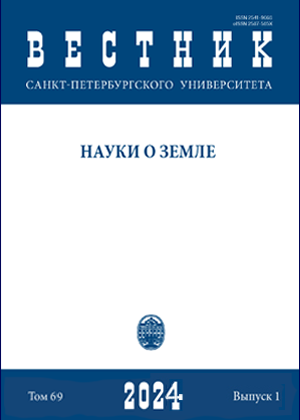Structure and age of the Rassokha granitoid massif (Arga-Tas Ridge, Eastern Yakutia)
DOI:
https://doi.org/10.21638/spbu07.2024.107Abstract
The Rassokha (Rassoshina) granitoid massif is located at the junction of the Rassokha and Argatass terranes, which are located in the western part of the Kolyma–Omolon microcontinent (superterrane), within the Verkhoyansk–Kolyma fold belt, extend in a northwesterly direction and border in the southwest with the Omulevka terrane of the passive continental margin, and in the north-the east is blocked by Cenozoic deposits of the Ozhogino depression. The massif is mainly composed of light gray, creamy massive and trachytoid porphyritic coarse- and medium-grained moderately alkaline leucogranites and alaskites. The age of the Rassokha massif and its ore mineralization was determined by a complex of isotope-geochronological methods such as U-Pb dating of zircon and Re-Os dating of molybdenite. U-Pb zircon age of the Rassokha massif is 165±0.7 Ma (n=38). The results of U-Pb dating of zircon indicate that the introduction of rocks of the Rassokha massif (alaskites, leukogranites and aplites) occurred in a relatively narrow time interval about 165 million years ago. The obtained values of the age of sulfide mineralization (179±11 million years), obtained by the Re-Os system in molybdenite isolated from alaskites, turned out to be older than the values of the U-Pb age of zircon. Most likely, some increase in the values of the Re-Os age reflects the heterogeneous isotopic composition of the captured osmium. The time of granitoids formation correlates with the early stages of Uyadino-Yasachenskiy volcanic belt formation, and most likely the massif represents intrusive part of volcanogenic belt complexes. Taking into account the geological position of the massif in the zone of the Argatass thrust, it is possible to assume the formation of granitoids in an environment of transform interaction.
Keywords:
Rassokha massif, granitoids, zircon, molybdenite, U-Pb age, Re-Os age
Downloads
Downloads
Additional Files
Published
How to Cite
Issue
Section
License
Articles of "Vestnik of Saint Petersburg University. Earth Sciences" are open access distributed under the terms of the License Agreement with Saint Petersburg State University, which permits to the authors unrestricted distribution and self-archiving free of charge.






